The Star Trek Aliens That Made TOS a Weirder (and Better) Sci-Fi Show
For a low-budget TV show from the 1960s, Star Trek came up with some wild forms of life.
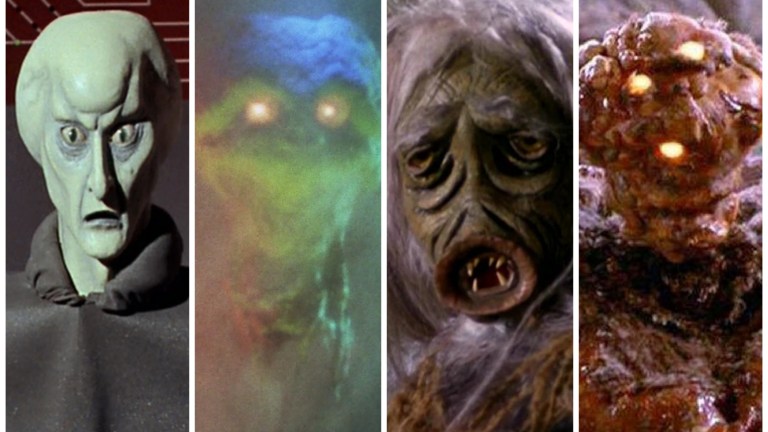
Even though it was a relatively low-budget TV show (by today’s standards, it was practically made for the cost of a home movie) and visual effects in the 1960s were limited (again, by today’s standards), Star Trek: The Original Series managed over the course of its three seasons to come up with some of the more decidedly weird alien races of the entire franchise.
While nowhere near as prolific in its production of monsters as its early ‘60s predecessor, The Outer Limits, which was mandated by its network to cough up a different boogeyman every week, Star Trek did turn out an interesting array of strange, creepy, or even psychedelic (this was the ‘60s, after all) deep space denizens – although in classic Trek fashion, many of them were not the threats that their hideous surfaces hinted at, and were often more advanced than us humans in our bags of bone, flesh, and blood.
What makes this even more surprising is that the rest of this now-vast franchise didn’t push the notion of aliens that didn’t look like us with more fervor as budgets and VFX opened up. While The Original Series had plenty of humanoid aliens wearing antennae, blue makeup, or furry facial appliances, shows like The Next Generation and Deep Space Nine often presented a generic array of humanoids often represented by nothing more than bumps, ridges, or armored plates on top of their heads or down the center of their noses.
Maybe the drugs in the ‘60s really did expand the minds of the writers, producers, and designers of The Original Series. Maybe it was the fact that the show hired legendary sci-fi writers like Theodore Sturgeon, Robert Bloch, and Harlan Ellison to pen multiple episodes. But as primitive as they may look now, TOS did give us some of the Trek universe’s most bizarre life forms, 10 of which we’ve featured below. And no, the Gorn is not on this list – we love him but he’s still just a guy in a lizard suit.
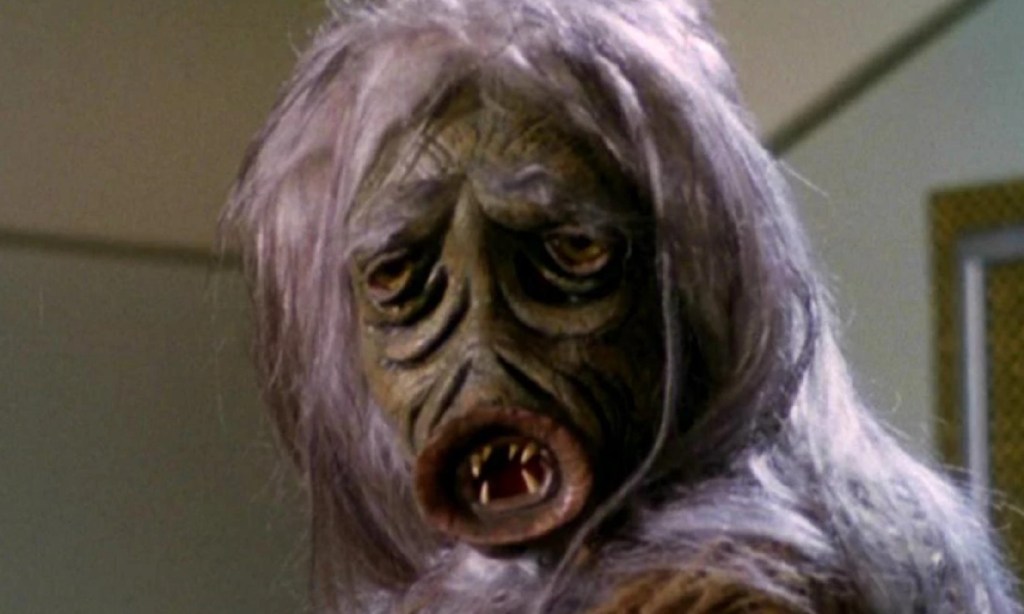
The Salt Vampire
Although we’re mostly avoiding humanoid aliens in this survey, our first two entries are decidedly humanoid in shape – if not relatable to humans by any other measure. The very first Original Series episode ever televised, “The Man Trap,” was centered around an ancient creature that feeds on salt – by fatally draining it out of its victims — and is the last of its kind. The salt vampire (the race is never named) is humanoid in shape, but features hooded, reptilian eyes, a snout-like spherical mouth with sharp teeth inside and long fingers covered in suckers that attach to its target’s face.
The creature is a shapeshifter, able to present itself as whatever its victim wants to see, which provided TOS with one of its earliest progressive moments: Uhura (Nichelle Nichols) encounters the creature in an Enterprise corridor, where it appears to her as a tall African man. The two speak Swahili, Uhura’s native tongue, in a moment that was pretty special (and rare) for early ‘60s national network TV. The story is also ultimately empathetic to the creature and its plight, setting the pace for future Treks to come.
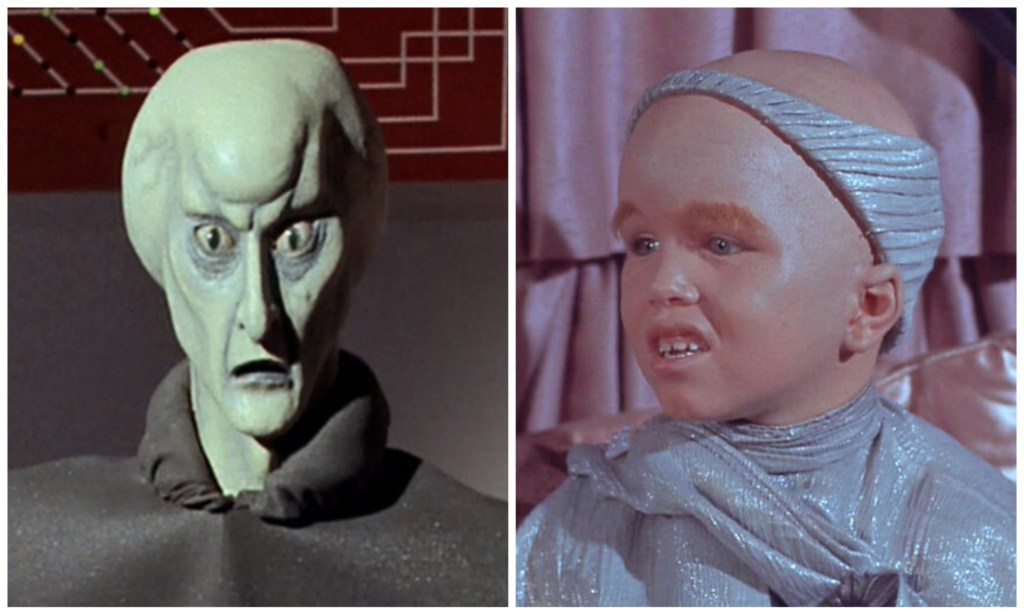
Balok
In the classic episode “The Corbomite Maneuver” (the 10th episode aired, but the first filmed in regular production), the Enterprise encounters a titanic vessel in uncharted space that claims to be from the “First Federation.” Its commander, Balok, appears onscreen with a rather sinister-looking, almost demonic visage and proceeds to put the Enterprise through a series of threats and challenges; when Kirk finally outwits Balok, they end up meeting face to face. While Balok admits this was all just a test to gauge how civilized humans are, what’s most bizarre is that Balok’s initial appearance was a puppet: his real form, to us, resembles a little boy.
That little boy was played by Clint Howard (Ron Howard’s younger brother) and while Balok is certainly humanoid, the effect of this powerful alien being housed in the body of a child and voiced by an adult actor (Walker Edmiston) makes this one of the most surreal and unexpected early moments in TOS history. Although we never really heard much more about the First Federation on any of the Trek shows, fleeting references popped up now and again – including the fact that Balok’s favorite drink, tranya, was served at Quark’s bar on Deep Space Nine. In addition, this mysterious confederation, like other TOS civilizations first introduced on TV, were part of several Trek novels, short stories, and video games.
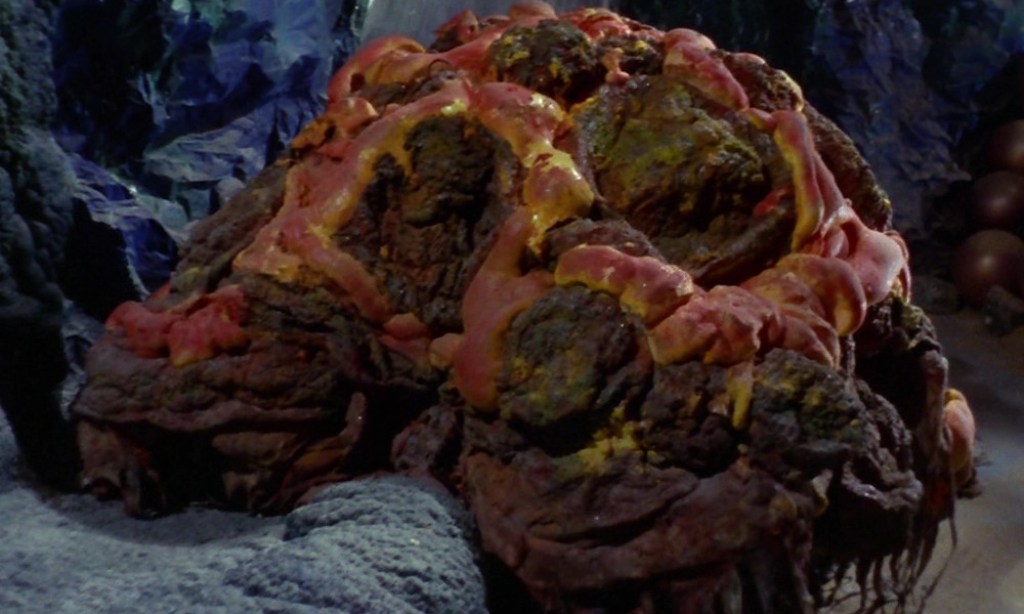
The Horta
One of the most popular Star Trek episodes of all time was “The Devil in the Dark,” in which the Enterprise is summoned to a mining colony to discover what is killing the miners down in the tunnels. It turns out that the rock-like “monster” laying waste to the miners is actually a peaceful silicon-based form of life called a Horta, who’s merely protecting her eggs – which the miners are inadvertently destroying by the thousands – like any mother would.
According to Star Trek legend, creature designer and stuntman Janos Prohaska crawled into TOS producer/writer Gene L. Coon’s office one day wearing the Horta costume, which more or less resembled a giant lasagna. Coon wasn’t sure what to make of it, but when he saw Prohaska “give birth” to an egg, he immediately hit on the idea for “The Devil in the Dark,” one of the original show’s most acclaimed tales. Fun fact: the costume got an earlier test run in The Outer Limits, where Prohaska played an oversized germ in the anthology series’ final episode, “The Probe.”
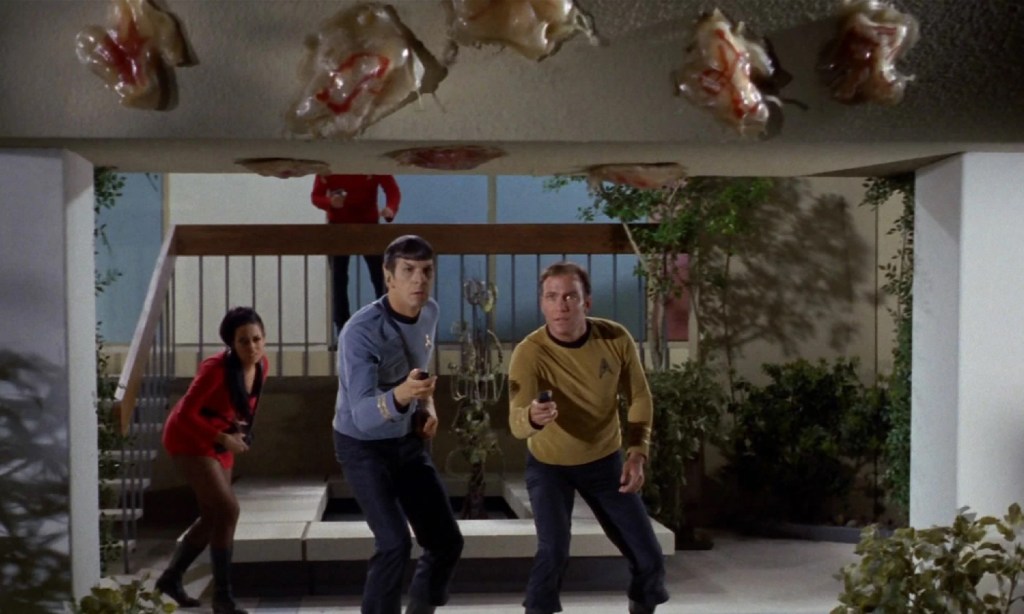
Denevan Neural Parasites
The final episode of the first season of TOS, “Operation – Annihilate!”, finds a colony on the planet Deneva – including Kirk’s brother Sam and his wife – decimated by an invasion of flying, parasitic creatures that attach themselves to human beings and drive them insane with pain. The creatures are shapeless blobs of jelly that Spock describes as resembling “brain cells.” He’s actually right on point: the individual lifeforms are all part of one hive mind – the creature itself – that implant themselves in the human nervous system so that the entity can use humans to spread itself through the galaxy.
The things and their physiology are so beyond the frame of human reference that Spock suggests they have come from outside our galaxy, and while the puppets used are rubbery-looking (and the strings making them “fly” can be glimpsed on hi-def versions of the episode), their cumulative effect and background is still unsettling (kind of like the gigantic space amoeba in the second season episode “The Immunity Syndrome,” although that was an exact opposite of the flying parasites, being one tremendous, mindless cell).
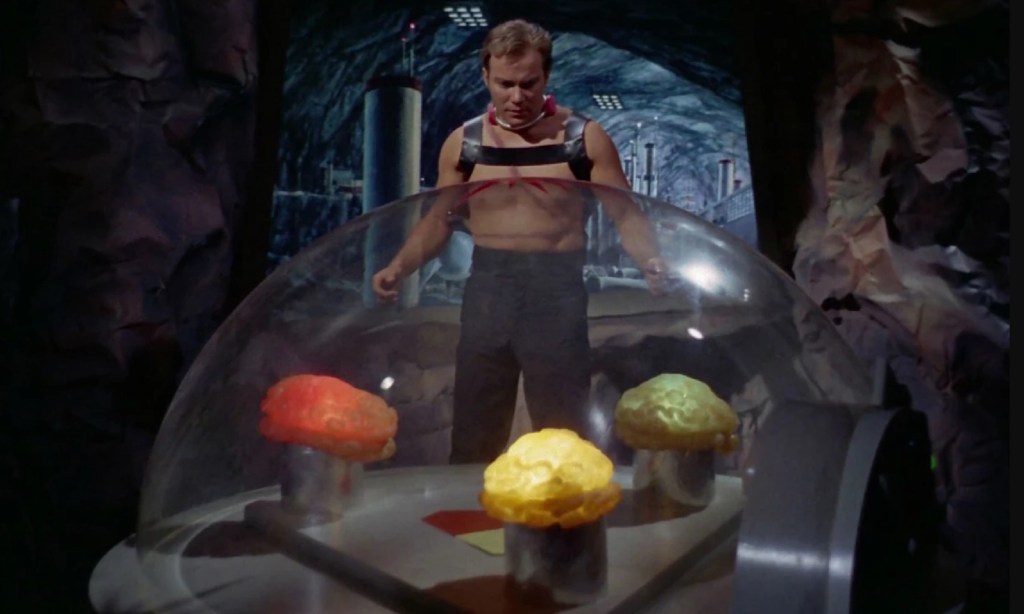
The Providers
In the second season’s “The Gamesters of Triskelion,” Kirk, Uhura, and Chekov are captured and transported to the title planet, where they are forced to compete in dangerous gladiatorial games with representatives of other alien races. It’s all for the amusement of the Providers, who enjoy wagering on the contests, and who turn out to be three glowing brains encased in a dome who – despite evolving past the need for anything but the most rudimentary physical form – have grown lazy and complacent.
The Providers – aside from their rather goofy appearance – are typical of TOS aliens in that they learn some kind of lesson thanks to Kirk and the Enterprise crew, eventually agreeing to stop using other beings as pawns for their games. It’s a stock TOS plot, but what makes it entertaining is that the Providers, despite their immense technological and mental power, speak down to others and bicker among each other like sneering, wealthy fat cats with too much time on their hands – which, in a sense, is what they are.
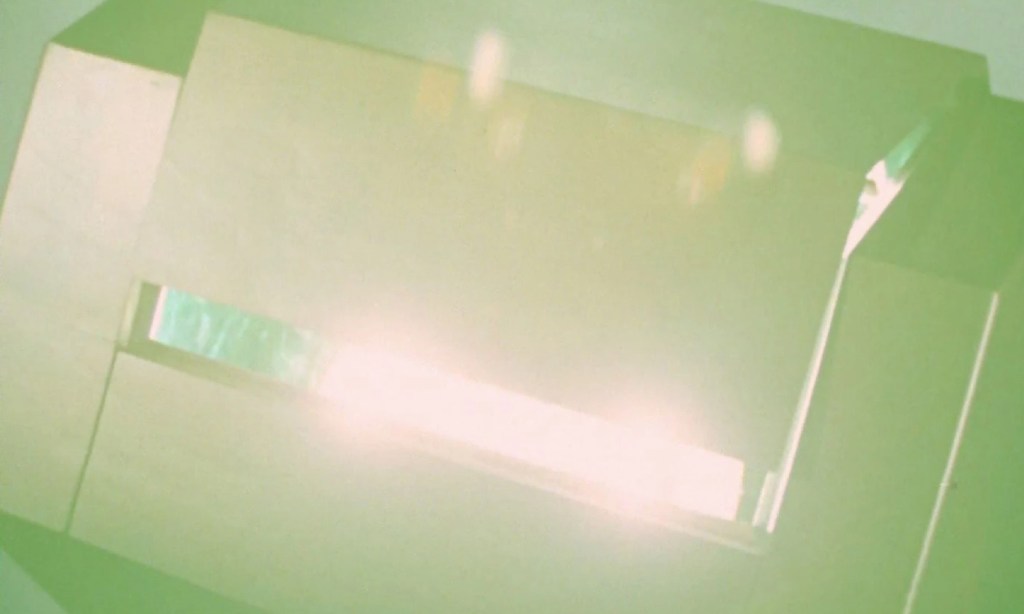
The Medusans
Fred Freiberger’s term as the producer of The Original Series’ lackluster third season will forever be debated by Trek diehards, but one thing that Freiberger was interested in doing was making the show’s aliens more…alien. His first attempt at that was season 3 episode 5, “Is There in Truth No Beauty?”, which introduced us to the Medusans – a non-corporeal race of supremely intelligent, highly advanced beings whose natural state is so hideous that a mere glimpse of them can drive human beings insane.
By this point in the series’ run, we’d already met beings like the Metrons (“Arena”) and the Organians (“Errand of Mercy”) that advanced beyond physical bodies, assuming human form when necessary to deal with lower species like us. But while the Medusans, represented in this rather soap opera-esque episode by Ambassador Kollos, can form mind-links with physical beings, they are otherwise carted around in a special box that can’t be opened with humans around, lest the phrase “resting bitch face” take on lethal new meaning. The episode itself is inconsistent with its own rules (in one scene, with the box closed, Spock wears a special visor while Kirk stands there with nothing on his head but his toupee), but turning the idea of what defines “beauty” upside down is in many ways a classic Trek theme (A Medusan also showed on Star Trek: Prodigy, this time wearing a robotic suit).

The Melkotians
One of the more infamous episodes from Star Trek’s third season is “Spectre of the Gun,” in which Kirk, Spock, Scotty, McCoy and Chekov are forced to refight the 1881 gunfight at the OK Corral in Tombstone, Arizona between the Earps and the Clantons, with the Enterprise men on the losing Clanton side. Although the story is a perfect embodiment of much of the silliness of the third season, there is an atmospheric moment near the beginning when our heroes beam down to the planet of the Melkotians – xenophobic aliens who wish no contact with the Federation – and meet one of its representatives.
Although somewhat obscured by swirling mists, the Melkotian (or Melkot, as it’s sometimes called) was one of the show’s eerier beings, with a floating, oversized, bulbous head, large, glowing eyes, and either tentacles or limbs dangling below. For Star Trek, it was downright Lovecraftian, although in typical TOS fashion, these initially hostile aliens are inviting the humans to a sit-down by the end of the episode (strangely, in the episode’s novelization, the Melkot is humanoid). The Melkotians were also one-and-done; despite opening relations with the Federation, we never hear from them again.
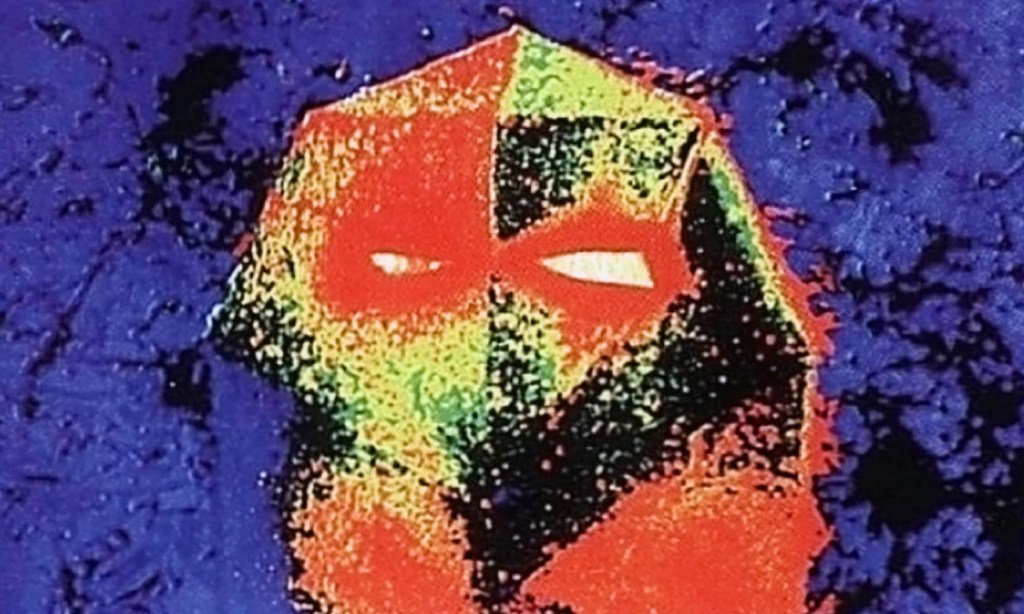
The Tholians
In the popular third season episode “The Tholian Web,” the Enterprise comes upon a sister starship, the Defiant, that is trapped in an interdimensional rift in space with all its crew dead. When Kirk disappears into the rift after being stuck on board the Defiant, Spock tries to rescue him – but his efforts are hampered by the appearance of a hostile race called the Tholians.
The Tholians are crystalline in appearance, with an angular, glowing head featuring just two triangular eyes. The Tholian commander, Loskene (voiced by Barbara Babcock), seems to appear against a very hot background, indicating that they need high temperatures to survive. Although they don’t seem to be known to the Federation, Spock comments on “the renowned Tholian punctuality,” hinting that the Vulcans may have run into them before. But as it turns out, the Federation (in a bit of retconning) has encountered them earlier as well: the Tholians were one of the few non-humanoid races to return to a later Trek series, showing up in the Enterprise episodes “Future Tense” (where only their ships are seen) and “In A Mirror, Darkly” (where a Tholian’s full, insectoid body is shown).

The Zetarians
A number of Star Trek aliens were of the “sparkling energy cloud” variety: in the episode “Obsession,” there was one that drank blood, another one was desperately horny for warp drive inventor Zefram Cochrane in “Metamorphosis,” and a third literally planted fake news into the heads of the Enterprise crew and a bunch of Klingons to get them to fight in “Day of the Dove.” But what made the Zetarians – the last, disembodied survivors of a race looking for a physical body that they can inhabit – so bizarre is not their twinkly lights but what they did to their victims.
Although they are so powerful that they end up shorting out most people’s brains, the Zetarians cause their targets’ faces to shift through all kinds of strange psychedelic colors while their voices sound like a vinyl record being spun very slowly on a turntable. It’s a pretty creepy effect in an otherwise unremarkable episode (it sure scared the hell out of this author as a wee lad), making the Zetarians a minor but still memorable addition to the Trek gallery of weirdness.

The Excalbians
The final non-humanoid alien race to appear on ST: TOS, the Excalbians showed up in the late third season episode “The Savage Curtain,” in which Kirk and Spock must fight alongside recreations of Abraham Lincoln and a Vulcan philosopher named Surak against a team made up of four of history’s most sinister figures. Orchestrating all this is the Excalbians, a race of rock-like beings who use such “plays” to educate themselves about other civilizations and concepts such as good and evil.
The Excalbians are represented by Yarnek, who initially disguises himself (itself?) as a boulder before revealing his true self – a massive being made of searingly hot “living rock” (the Excalbians’ planet is mostly lava) with flashing, bulbous eyes and claw-like appendages. No doting mother like the other TOS rock monster, the Horta, Yarnek – and by extension, his people – is extremely powerful (they’re able to manipulate matter) and totally cool with forcing other beings to act out their little shows.
Star Trek: The Original Series can be streamed on Paramount+.
